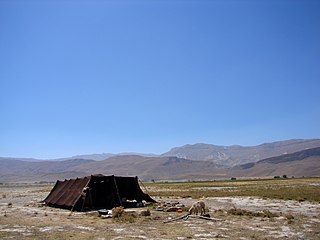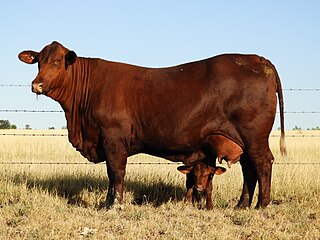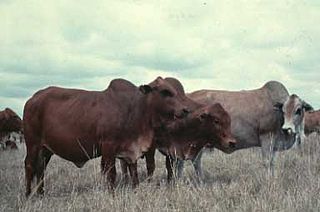Related Research Articles

The aurochs is an extinct cattle species that was first described in 1827. With a shoulder height of up to 180 cm (71 in) in bulls and 155 cm (61 in) in cows, it was one of the largest herbivores in the Holocene; it had massive elongated and broad horns that reached 80 cm (31 in) in length.

The zebu, sometimes known in the plural as indicine cattle or humped cattle, is a species or subspecies of domestic cattle originating in the Indian sub-continent. Zebu are characterised by a fatty hump on their shoulders, a large dewlap, and sometimes drooping ears. They are well adapted to withstanding high temperatures, and are farmed throughout the tropical countries, both as pure zebu and as hybrids with taurine cattle, the other main type of domestic cattle. Zebu are used as draught and riding animals, dairy cattle, and beef cattle, as well as for byproducts such as hides and dung for fuel and manure. Some small breeds such as the miniature zebu are also kept as pets. In 1999, researchers at Texas A&M University successfully cloned a zebu.

The Nguni is a cattle breed indigenous to Southern Africa. A hybrid of different Indian and later European cattle breeds, they were introduced by Bantu-speaking tribes to Southern Africa during their migration from the North of the continent.

Pastoralism is a form of animal husbandry where domesticated animals known as livestock are released onto large vegetated outdoor lands (pastures) for grazing, historically by nomadic people who moved around with their herds. The species involved include cattle, camels, goats, yaks, llamas, reindeer, horse and sheep.

The Afrikaner, also known as the Africander, is a breed of taurine-indicine ("Sanga") cattle indigenous to South Africa.

The Senepol breed of beef cattle was developed on the Caribbean Island of St. Croix. It has long been thought that Senepol originated from crosses between N'Dama cattle, imported in the late 19th century, and Red Poll cattle, but it is actually an admixed breed between a European taurina and zebu. The Senepol breed combines characteristics of heat tolerance and insect resistance with the docile nature, good meat, and high milk production of the Red Poll. They are polled, short haired, and colored red, black or brown.

The Santa Gertrudis is an American breed of beef cattle. It is a taurine-indicine hybrid breed, descended from both zebu and European cattle. It was bred in the early twentieth century in Texas, and received official recognition in 1940. It has been exported to many countries including Australia, Brazil and South Africa, and has contributed to the development of a number of modern breeds, among them the Barzona and the Droughtmaster.

Red Sindhi cattle are the most popular of all Zebu dairy breeds. The breed originated in the Sindh province of Pakistan, they are widely kept for milk production across Pakistan, India, Bangladesh, Sri Lanka, and other countries. They have been used for crossbreeding with temperate (European) origin dairy breeds in many countries to combine their tropical adaptations with the higher milk production found in temperate regions. It has been crossed with Jerseys in many places, including India, the United States, Australia, Sri Lanka, etc.

Boran cattle are a popular Zebu beef breed in eastern Africa.
The Abyssinian Shorthorned Zebu is an Ethiopian breed or group of breeds of zebuine cattle. It is not reported to DAD-IS as a breed.

Sanga cattle is the collective name for indigenous cattle of sub-Saharan Africa. They are sometimes identified as a subspecies with the scientific name Bos taurus africanus. These cattle originated in East Africa, probably the western shores of Lake Victoria, and have spread down the river Nile, with depictions on Ancient Egyptian murals. Sanga are an intermediate type, probably formed by hybridizing the indigenous humpless cattle with Zebu cattle. However, archaeological evidence indicates this cattle type was domesticated independently in Africa, and bloodlines of taurine and zebu cattle were introduced only within the last few hundred years. The timeline for their history is the subject of extensive debate. A combination of genetic studies with archaeological research, including cultural history, has clarified the question of the complex origin of African cattle in recent years. Thus African cattle descend firstly from an aurochs domesticated in the Near East. After their introduction to Egypt, about eight thousand years ago, they spread all over the Sahara which was then still green, up to West Africa. The north African pastoralists interbred their domestic cattle with wild African Aurochs of various regional races, both in the paternal and maternal lines over a long time, which is reflected in the genetic distinctness of African cattle from both European / near Eastern and from Indian Zebu cattle. Hereby special adaptations to the African climate and conditions were introduced, that characterise African cattle - both those deriving solely from Aurochs and the Sanga cattle with their Zebu admixture. Morphological features of early African cattle, such as lyre-shaped horns, are depicted on murals of Ancient Egypt. Some authors date the first Sanga cattle, which originated through by crossing in of Zebu bulls in northeast and east Africa, from 1600 BC on. They are distinguished by having small cervicothoracic humps, that are typical for (wild) Aurochs, instead of the high thoracic humps which characterize the Zebu.
The Red Fulani is an African breed of cattle found from Mali across Niger and northern Nigeria to Chad and Cameroon.

The Indian aurochs is an extinct aurochs subspecies that is considered the wild ancestor of the domestic zebu cattle, which is mainly found in the Indian subcontinent and has been introduced in many other parts of the world, like Africa and South America. In contrast, the domesticated taurine cattle breeds, which are native to Europe, the Near East, and other parts of the world, are descendants of the Eurasian aurochs. According to IUCN, the Indian aurochs disappeared before the 13th century AD, leaving only the Bos primigenius primigenius, whose range was by then restricted to Europe. The wild population of Indian aurochs was likely extinct millennia earlier than that; the most recent skeletal remains, from Uttar Pradesh, date from around 1,800 BC.

Taurine cattle, also called European cattle, are a subspecies of domesticated cattle originating in the Near East. Both taurine cattle and indicine cattle (zebus) are descended from the aurochs. Taurine cattle were originally considered a distinct species, but are now typically grouped with zebus and aurochs into one species, Bos taurus. Most modern breeds of cattle are taurine cattle.

The red and black coated Arado cattle are small and hardy. They are the most common cattle variety in the north Ethiopian highlands. The Arado breed is part of the Zenga breed group. It is essentially reared for draught power, particularly tillage. The breed feeds mainly on crop residues; it is adapted to seasonal feed shortages. This breed is often cross-bred through bull and artificial insemination services.

The long-horned Raya cattle are a breed of cattle common in the Tigray Region of Ethiopia. The Raya cattle have red and black coat colours. Bulls and oxen have thick and long horns and a cervicothoracic hump; cows have medium, thin horns. Raya cattle are closely related to the Afar cattle; this is a result of historical cattle raiding by the Raya people. The Raya cattle are however adapted to draught animals for tillage in the croplands of the highlands.
The Afar cattle are mainly found on the western margins of the Danakil Depression in Ethiopia. The Afar cattle have thick and long horns and a cervicothoracic hump; they are essentially reared for milk production.

The Abergele cattle are the smallest breed of north Ethiopia. They are reared in the Abergele lowlands and at the southwestern lower slopes of Dogu'a Tembien district. Abergelle cattle are part of the Zenga breed group. The Abergele breed is known for its adaptation to the hotter and drier lowlands. It is also very tolerant to diseases and parasites and can cope with feed shortages during long dry periods.
Fogera cattle is an Ethiopian breed of cattle. One of its typical characteristics are broad hoofs, that allow it to move more easily in the marshes of the Fogera Plain. At Woreta, the agricultural research centre specialises in preserving the breed.
References
- 1 2 3 Merha Zerabruk, and colleagues (2011). "Genetic diversity and admixture of indigenous cattle from North Ethiopia: implications of historical introgressions in the gateway region to Africa". Animal Genetics. 43 (3): 257–266. doi:10.1111/j.1365-2052.2011.02245.x. PMID 22486496.
- ↑ Cattle breeds, milk production, and transhumance in Dogu'a Tembien. In: Geotrekking in Ethiopia's tropical mountains, Chapter 28. Cham: SpringerNature. 2019. doi:10.1007/978-3-030-04955-3_28. S2CID 199323600.
- 1 2 3 Hanotte, O. and colleagues (2002). "African pastoralism: genetic imprints of origins and migrations". Science. 296 (5566): 336–339. Bibcode:2002Sci...296..336H. doi:10.1126/science.1069878. PMID 11951043. S2CID 30291909.
- ↑ Pankhurst, R (1985). The history of famine and epidemics in Ethiopia prior to the twentieth century. Addis Ababa: Relief and Rehabilitation Commission.
- ↑ Van Cappellen, H (2016). The ox-plow complex on the edge: an ethnographic inquiry into social change and cross-breed dairy farming in Tigray, Ethiopia [MSc Thesis]. KU Leuven, Belgium.